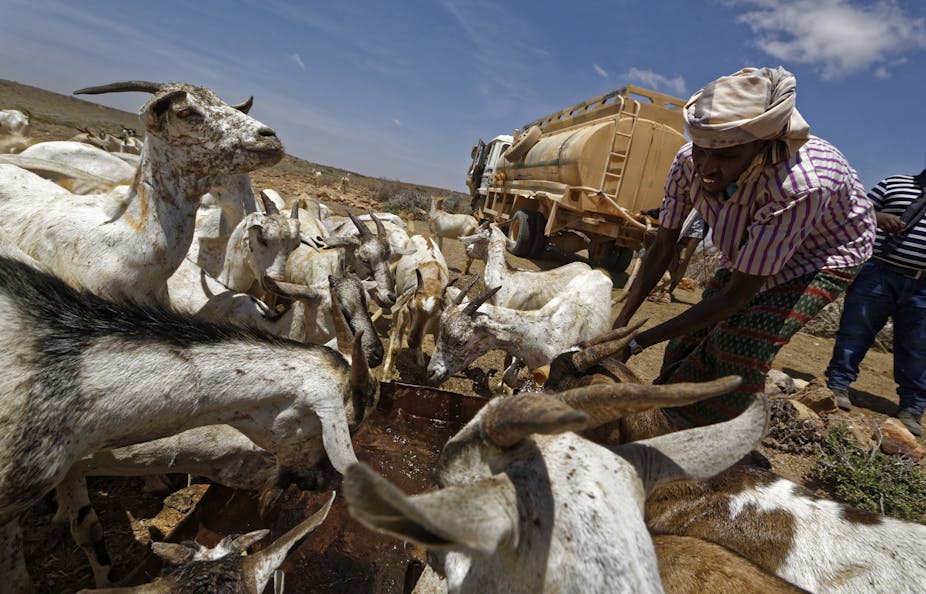In 2016, Somalia was declared the most fragile state in the world – worse off than Syria.
In February 2017, the United Nations issued an early famine warning for the country, which is suffering from drought, clan warfare, government corruption and attacks from the Islamic militant group, al-Shabab. Adding to the misery, President Trump has attempted to ban Somali refugees’ entry into the U.S.
Yet, as an academic who studies European and African state and nation building, I see three reasons for hope in Somalia.
1. Building stable institutions
For the first time since the 1991 overthrow of former dictator Siad Barre and the collapse of central government authority, Somalia has newly functioning political institutions.
In 2004, a transitional federal government tried to centralize the government but failed to hold elections. During the 2011 famine, the delivery of humanitarian aid was disrupted by recurring clan warfare. Somalis realized they needed stronger, legitimate political institutions to control and unify their national territory.
There are four major and many minor Somali clans, each with its own traditions and territories. Clan divisions have had a significant impact on Somalia’s status as a fragile state.
By 2012, and with help from the U.N., the clans agreed to a power sharing formula to allocate parliamentary seats. The agreement helped the clan elders come together and led to the first formal parliament in 20 years.
Elections followed, but cautiously. The 2016 parliamentary elections and the 2017 presidential elections built on the formula created in 2012, but with more delegates participating to elect the parliament. To avoid violence from the clans or Al Shabab contingents, the vote for president was limited to members of the upper and lower houses of parliament, the members of which were chosen by the clans. They cast ballots at a heavily guarded air force base in Mogadishu.
Citizen response to the election of President Mohamed Abdullahi Farmajo was enthusiastic. He took office on Feb. 8, 2017, in a smooth transition from the former President Hassan Sheikh Mohamud. He declared an era of unity. Farmajo’s experience of living in the United States – he holds dual citizenship and graduated from SUNY, Buffalo – and remittances from the Somali diaspora may help the economy grow and democratic values take hold.
The new president is representative of the almost two million Somalis who left the country, many between 1990 and 2015, and the significant number who have returned from abroad. Somalia is home again to many former refugees to the U.S., Canada and Europe who have dual citizenship and good educations. Many of these returnees have shown an interest in politics.
Indeed, one-third of the elected candidates in the 2016 parliamentary election hold foreign passports. Out of the 275 members of the Somali parliament, 22 are Somali-Americans and 29 are British Somalis. The 48-year-old prime minister, a former senior official in the Soma Oil and Gas exploration company, is a dual Somali-Norwegian citizen.

2. Better famine preparedness
The existence of more stable government than before the 2011 famine allowed the prime minister to act faster to declare the 2017 drought a natural disaster.
In the 2011 famine, international aid groups in Somalia were hampered by lack of access to affected regions, clan warfare and dangerous conditions caused by a state of anarchy. Aid often went undelivered.
By 2012, thanks to the power sharing agreement reached by the clans, warfare had declined and aid delivery improved. Overall funding for Somalia in 2016 amounted to US$637.7 million.
Funding from the U.S. and the EU is an important support for the new government. The U.S. provides significant aid for political and economic recovery, as well as humanitarian and military aid to fight al-Shabab and improve state security.
The EU has donated over 1.2 billion euros since 2008 through the European Development Fund.
Aid reaches its targets better now that the country is more stable. However, there is also growing recognition that to be successful, development must be more rooted in Somalia.
3. Progress against al-Shabab
Protecting borders is vital for state building. Forces favorable to the Somali government have made advances against al-Shabab militants since 2012. The retreat of al-Shabab in many regions suggests that Somalia can defend its borders better now.
Funding cuts under the recent EU budget will affect the African Union’s Somalia mission of fighting al-Shabab. There are expectations, however, that the U.S. will increase military spending in Somalia to offset this loss.
Since 2007, the U.S. has played an important role in fighting al-Shabab, for example by carrying out drone strikes. In addition, The New York Times reports that the U.S. has helped pay for an African Union stabilization force in Somalia. About 50 U.S. commandos remain in Somalia, with the ability to launch air strikes and accompany Somali troops on missions. They may soon do more.
Hope for the Somali state
Despite the challenges of famine and continuing threats from al-Shabab, a stronger Somalia seems possible. Liberia and Sierra Leone are examples of countries that have successfully managed their state building and made similar turnarounds.
Somalians want to rebuild their state from the bottom up, depending more on domestic sources. Unfortunately, Somalia’s current recovery is fragile and could easily derail. The recent attack on Somali refugees off the coast of Yemen highlights continuing problems. Now is not the time for a ban on Somali refugees entering either the EU or the U.S. A more stable Somali government should merit some reconsideration of this order.

